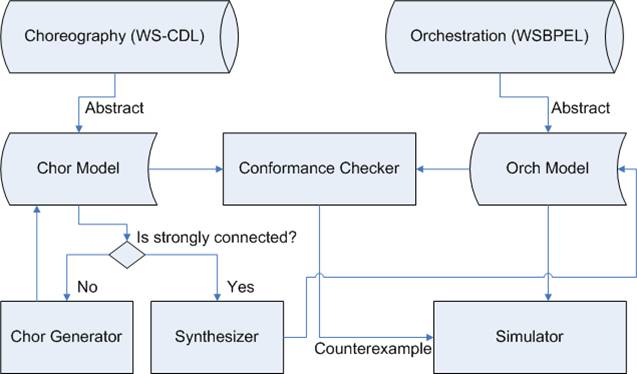 Process
Analysis Toolkit (PAT) 3.5
Help Process
Analysis Toolkit (PAT) 3.5
Help |
The Web Services paradigm promises to enable rich, dynamic, and flexible
interoperability of highly heterogeneous and distributed web-based platform. In
recent years, many Web Service composition languages have been proposed. There
are two different viewpoints, and correspondingly two terms, in the area of Web
Service composition. Web Service choreography is usually referred to Web Service
specification which describes collaboration protocols of cooperating Web Service
participants from a global view. An example is WS-CDL (Web Service Choreography
Description Language). Web Service orchestration refers to Web Service
descriptions which take a local view. That is, an orchestration describes
collaboration of the Web Services in predefined patterns based on local decision
about their interaction with one another at the message/execution level. A
representative is (a main part of) WS-BPEL (Web Service Business Process
Execution Language), which models business process by specifying the workflows
of carrying out business transactions. Informally speaking, a choreography may be viewed as a contract among
multiple cooperations, i.e., a specification of requirements (which may not be
executable). An orchestration is the composition of concrete services provided
by each cooperation which realizes the contract. The distinction between
choreography and orchestration resembles the well studied distinction between
sequence diagrams (which describes inter-object system interactions) and state
machines (which may be used to describe intra-object state transitions).
Likewise, there are two important issues to be solved. If both the choreography
and orchestration are given, it is important to guarantee that the two views are
consistent, by showing that the orchestration (i.e., implementation) conforms to
the choreography (i.e., specification). Given only a choreography, it is
necessary to check whether it is implementable and synthesize a prototype
implementation (if possible). Web Service Module offers practical solution to
both issues, which is self-containing environment for analyzing Web
Services (abstractions). The user interface of Web Service Module supports
user-friendly editing, simulating and verifying of Web Services. In particular,
conformance is verified by showing weak simulation relationship using an
on-the-fly model checking algorithm. A scalable lightweight approach is used to
solve the synthesis problem.
Figure above shows the workflow of Web Service Module. Given a choreography
or an orchestration, a preprocessing component is used to extract relevant
information and build a simplified model, in intermediate languages which are
designed to capture behaviors of choreography and orchestration. The reason
for supporting intermediate languages is twofold. Firstly, heavy languages like
WS-CDL or WS-BPEL are designed for machine consumption and therefore are lengthy
and complicated in structure. Our intermediate languages focus on the
interactive behavioral aspect. Both languages (for choreography and
orchestration) have their own parser, compiler as well as formal operational
semantics. Therefore, users can quickly write a Web Service model and analyze it
using our visualized simulator, verifier and synthesizer. The languages are
developed based on previous works of formal models for WS-CDL and WS-BPEL (See
next
section for details). They cover all main features like
synchronous/asynchronous message passing, channel passing, process forking,
parallel composition, shared variables, etc. Secondly, Web Service languages are
evolving rapidly. Being based an intermediate language gives us opportunity to
quickly cope with new syntaxes or features (by tuning the preprocessing
component). Given a choreography, Web Service Module can statically analyze whether it is
well-formed, for instance whether it can be implemented in a distributed setting
without introducing unexpected behaviors. If the choreography is not
implementable, Web Service Module generates an implementable one, by injecting
extra message passing into the choreography. Otherwise, Web Service Module may
be used to automatically generate a prototype orchestration (which may later be
refined and translated to a WS-BPEL document). If an orchestration is provided,
the conformance checker allows users to verify whether the orchestration is
valid with respect to the choreography. Currently Web Service Module is still in beta stage. We are actively
developing it now. Any suggestion or feedback is extremely
welcome.
Copyright © 2007-2012 Semantic Engineering Pte. Ltd.